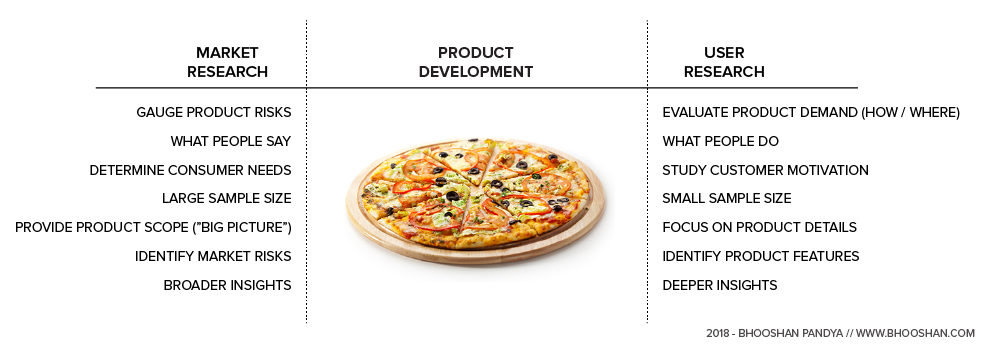I have often had conversations with clients and designers who have a difference of opinion on the virtues of ‘market research’ and ‘user research’, sometimes even using the terms interchangeably. In one such recent interaction with a marketing executive from a large Canadian company with whom I was associating for a consulting project, I was told that ‘user research’ was not necessary for the current circumstances since his company was perfectly cognizant of its customer base. He was referring to the marketing research his team was involved with, and rightly so. In all this, I believed, his goal was to expedite product development by paring down the number of hours and the expenditure required for the user research phase. It should come as no surprise for designers and managers, that a large chunk of their product design commitment relies on a comprehensive overview of the customer base gained from research studies at different times, and any form of research which could serve various purposes during a product’s development journey.
[perfectpullquote align=”right” bordertop=”false” cite=”” link=”” color=”” class=”” size=””]An ardent proponent of the UCD methodology, I firmly believe in the potential of research data in gathering an informed opinion about the motivations of the actual users which would enable me in developing a product’s design strategy, this includes presiding over focus group sessions, moderating personal interviews, or conducting a contextual inquiry study.[/perfectpullquote]
The user research exercise is not just relevant to the current state of the product analysis, but as the audience evolves and the product begins to feel redundant, the overlapping data from the market research and user research becomes that much more critical in the product’s design goals. Incidentally, some experts believe in the difference between market research and marketing research though I would like to set aside that debate for now. Instead, the question which I aim to examine in my article deals directly with the significance of market research and user research from the context of a product’s development lifecycle.
From the onset, I need to clarify that the Market Research and User Research areas use the qualitative and quantitative methods of inquiry, and it’s always preferred to start with the Market Research to get a broader perspective before diving into the specific behavioural aspects of the users with the User Research.
Market Research (or How To Make A Better Pizza?)
Let me make an attempt to define Market Research in simple terms through the story of Ron who is in the business of retailing pizzas. Ron is the experienced restaurateur of a pizza place who understands the value of good customer experience. Since in the wake of growing competition he runs the risk of losing customers to his neighbourhood pizza shop which is owned by Jon. For Ron’s pizza retail business to stay relevant it has become imperative that his staff listens to his customer needs – their likes and dislikes, so he is better prepared to anticipate the needs of his ever-evolving consumer tastes in their selection of toppings, sauces, and spices, but that’s not everything. His restaurant’s patrons have begun making informed food choices about their selection of pizza doughs which has seen a dramatic shift towards healthier options such as whole wheat and multigrain over regular refined flour dough which is becoming less popular. Ron has also keenly observed the choices of certain age groups in his restaurant, so he knows what motivates youngsters to choose items on the menu over the rest, which encourages him to innovate the menu of his speciality pizza outlet periodically. In simple terms, through his extensive eye for research, Ron is unknowingly dealing with data related to Market Trends and Market Segmentation. For the purpose of this writing and in drawing a parallel with the software business, I’d take the object ‘pizza’ as the ‘product’ and Ron’s restaurant as the company which is responsible for the product development.
To sum up the narration of the Market Research activity, it provided some wide-ranging insights to Ron about his business and now it’s up to him to decide upon the appropriate changes going forward. The most important factor in Ron’s discovery is the market trend which is moving towards healthier food choices which could be reflected on his restaurant menu although he’s still clueless about what ‘items’ could be termed as saleable. Secondly, the research has also pointed at a certain category of consumers at his restaurant (demographic study) who prefer a healthy pizza, but would it just be pizzas or should there be a choice of salads too? Should ‘a healthy pizza’ carry a healthy choice dough or just the toppings or both? What about the cheese? It’s quite a broader, yet a useful piece of insight for Ron to turn his attention.
Market Research is all about providing the “big picture” view. It involves a larger sample size and focusses generally on the consumer’s buying habits, often pointing at an existing or evolving industry trend.
User Research (or How To Enhance the Pizza?)
Sometimes also referred to as ‘UX Research’ but it broadly entails the same goals. Now let’s shift gears and look at Ron’s pizza business through the prism of User Research, notwithstanding the insights he gained from his customers with the Market Research which gave him ample data on vast customer needs. With their endorsement given, Ron rounds up a specific category of customers to speak with and to observe them closely as they frequented his restaurant, those patrons he selected were mostly between the ages of 24-30 years, a smaller sample size than the Market Research phase which safely concluded that there are more ‘GenY-ers’ and ‘millennials’ who consume his pizza regularly. Giving an insightful background to his detailed questions allowed Ron to build a personal rapport with his respondents who seemed more than willing to help him with data on their personal preferences of healthy pizzas. They also inform Ron that it’s not just the pizzas which they relish but also his service and the ambience which they wished could do with more sunlight in a seemingly hot bakery structure. Among the healthier choices of pizzas, a large number of respondents also demanded a gluten-free variety of pizza dough with more selection of fresh vegetables such as asparagus. That kind of insight was more specific and helpful for Ron to chart his next course of action!
User Research is more focussed on how products are designed. It is about understanding a solution that best fits the needs of the user and analyzing their feelings as they use the product.
In Conclusion
In order to achieve the desired results it depends largely upon the quality of the questions framed and the style of questioning itself during his market research and user research phases, however, it’s evident from the two narratives that each exercise in research resulted in a different outcome. In contrast with Market Research, the ‘User Research’ activity was characterized in the way that Ron’s customers were outlining their choices with finer details. To sum things up, the table below clearly outlines the difference in the data gathered from both the research activities. You may agree, that although the data may appear disparate, their value in the overall scheme of product development (the pizza) cannot be overstated.

From a standpoint of the ‘pizza as a platform’ narrative, let’s revisit my abstract of the invaluable data produced by the two research methods for making a great product.
If you want to make a ‘pizza’, then…
Market Research might say…
[perfectpullquote align=”right” bordertop=”false” cite=”” link=”” color=”” class=”” size=””]
- More consumers are preferring healthy pizzas (Trends)
- Ages 24-40 are ordering more pizzas (Segmentation)
- Company A is selling more pizzas than Company B, because… (Competitor Analysis)
[/perfectpullquote]
…and User Research would say…
[perfectpullquote align=”right” bordertop=”false” cite=”” link=”” color=”” class=”” size=””]
- Let’s observe people having a pizza (Contextual Inquiry)
- Develop scenarios on how exactly would the consumers prefer their pizzas (Storyboarding)
- Create & serve a gluten-free pizza and note the audience reactions! (Prototyping & Iteration)
[/perfectpullquote]


